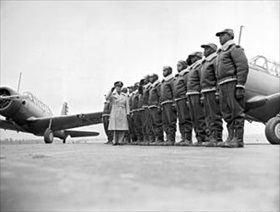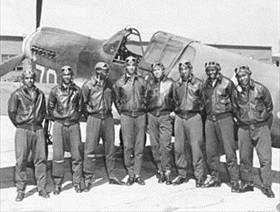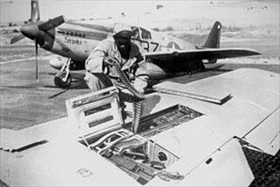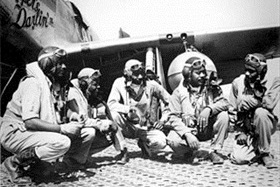FIRST BLACK FIGHTER SQUADRON FORMED
Chanute Field, Rantoul, Illinois · March 19, 1941
Pressed on one side by black news media and civil rights groups demanding that pilot training be opened up to African Americans and on the other by an upcoming re-election, President Franklin D. Roosevelt in 1940 authorized the creation of a segregated flight school and an all-black fighter squadron. On this date in 1941 in Illinois, the Army Air Force’s 99th Pursuit Squadron (“pursuit” being the pre-World War II term for “fighter”) was activated. Over 270 African American enlisted men became the pioneering core of black squadrons forming at Moton and Maxwell Fields in Macon County, Alabama. In June 1941 the program began officially with the formation, at Tuskegee Institute, of the 99th Fighter Squadron, the first flying unit for African Americans, earning program participants their nickname—Tuskegee Airmen. The airmen and ground crew were placed under the command of Capt. Benjamin O. Davis, Jr., then one of the few black graduates of West Point. Tentatively scheduled to fly air defense over Liberia, the combat-ready 99th was diverted to Tunis, North Africa, to support the Allied invasion of Sicily in July 1943 (Operation Husky). The following year the squadron provided close air support for Lt. Gen. Mark Clark’s U.S. Fifth Army in Italy during its assaults on Foggia and Anzio and for French and Polish armies in their attack on the historic hilltop abbey, Monte Cassino. In mid-1944 the 99th was assigned to conduct bomber escort missions over Romania, France, Austria, Czechoslovakia, Poland, Yugoslavia, and Greece. In all, Tuskegee aviators, who eventually numbered close to 1,000, flew more than 15,000 missions, shot down 111 enemy planes, and destroyed or damaged 273 on the ground at a cost of 66 of their own planes. More than 10,000 black men and women served as their vital support personnel. For its wartime efforts the squadron earned three Distinguished Unit Citations. The unquestionable excellence and commitment of the Tuskegee Airmen drove home to military and civilian authorities alike the illogic and inefficiency of racial segregation in the U.S. military. Their record helped persuade the Air Force—largely for reasons of operational self-interest—and President Harry S. Truman to move to desegregate the armed services after the war.
[amazon_carousel widget_type=”ASINList” width=”600″ height=”200″ title=”Recommended Reading” market_place=”US” shuffle_products=”False” show_border=”False” asin=”1588382443,1846030447,1565548280,0199896550,1560989173,0823223663,0061261386,1603061479,0738500453,0486485005″ /]
Tuskegee Airmen, the First African American Military Aviators in the U.S. Armed Forces
 |  |
Left: Maj. James A. Ellison reviews the first class of Tuskegee cadets and the flight line at the U.S. Army Air Corps basic and advanced flying school, Tuskegee, Alabama, 1941. During its five-year history the flying school trained almost 1,000 aviators, and nearly half served in combat during the war, compiling an impressive record flying 15,000 sorties in North Africa, Sicily, and Italy.
![]()
Right: Tuskegee Airmen, circa May 1942 to August 1943. Location unknown but likely Southern Italy or North Africa.
 |  |
Left: 99th Fighter Squadron mechanic reloading a P‑51 Mustang, September 1944.
![]()
Right: Five members of the Fifteenth Air Force 332nd Fighter Group at Ramitelli Airfield, Foggia, Italy, circa August 1944. Formally, the 99th Fighter Squadron formed the 332nd Fighter Group and the 477th Bombardment Group of the U.S. Army Air Forces. They were known as “Red Tails” for the distinctive crimson tails adorning their P‑51 Mustangs; they earned their affectionate nickname “Red Tail Angels” for staying close to the B‑17 and B‑24 bombers they escorted over Central and Southern Europe. German adversaries both feared and respected the African American pilots, calling them “Schwarze Vogelmenschen” (“Black birdmen”).
U.S. Army Air Forces’ Tribute to Tuskegee Airmen
![]()

 History buffs, there is good news! The Daily Chronicles of World War II is now available as an ebook for $4.99 on Amazon.com. Containing a year’s worth of dated entries from this website, the ebook brings the story of this tumultuous era to life in a compelling, authoritative, and succinct manner. Featuring inventive navigation aids, the ebook enables readers to instantly move forward or backward by month and date to different dated entries. Simple and elegant! Click
History buffs, there is good news! The Daily Chronicles of World War II is now available as an ebook for $4.99 on Amazon.com. Containing a year’s worth of dated entries from this website, the ebook brings the story of this tumultuous era to life in a compelling, authoritative, and succinct manner. Featuring inventive navigation aids, the ebook enables readers to instantly move forward or backward by month and date to different dated entries. Simple and elegant! Click 











